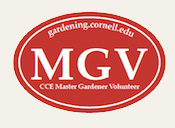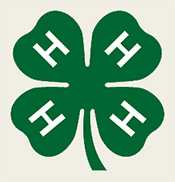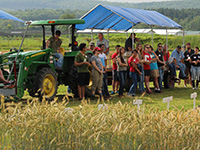Back to Sowing the Seeds of Success Homepage
Grassroots Fundraising
Grant Writing
Searching for Opportunities
Promotion
When you get a group of individuals together, begin to discuss program challenges, and it’s inevitable: the topic of raising funds, not having enough funds, or a fear of lack of funding will probably surface. Develop a plan with this Fundraising Plan Worksheet (pdf).
Regardless of the scope or audience of your garden project, at some point you will likely have to raise funds or secure in-kind donations to support the creation and maintenance of the garden, or to advance facets of the garden program. There are many strategies, ranging from grassroots approaches, that involve lots of people while garnering relatively fewer funds, to grants that can provide significant dollars, but require writing skill. Improve your chances of success by employing several approaches.
There is tremendous “in-kind value” in the time that volunteers, teachers, parents, administrators and community members lend to the program effort. Here, however, we will focus on two approaches to raising monies and donations: grassroots fundraising and grant writing.
“I learned early on that asking is not about asking for a handout, but asking for partnership in achieving a shared goal or vision. There is simply no way an organization or nonprofit project can be successful without a lot of community input. That input takes many forms, and one important form is financial. Some people are uncomfortable talking about money, but it is a gift to educate community members about your work and invite them to take part in it! I can hardly think of a more rewarding project to be invested in as a philanthropist than in a youth-based garden (but then again, I am slightly biased!).” –Erin Marteal, Executive Director at the Ithaca Children’s Garden in Ithaca, NY

Grassroots Fundraising
- Before approaching businesses, we suggest creating a Project Folder. Use this Project Folder Checklist (pdf).
- Having a well-prepared Elevator Speech is a good idea for any project, establish one using this Elevator Speech Activity (pdf).
From dollar drives to bake sales, this method is important since it doubles as a publicity opportunity and can create a strong sense of ownership among contributors. One school brought the circus to town each year to raise money for the garden. This fundraiser generated about $1000 annually, and of course, provided an enjoyable venue for hundreds of families and community members, all of whom were investing in the garden while having a good time. Another community program created small, inexpensive bouquets and sold dozens of them in the highly visible foyer of the local supermarket for Mother’s Day.
Consider:
- These methods can be time and energy intensive.
- They are an excellent way to engage youth in the fundraising process, since young people can identify approaches and follow through on each aspect of planning and completion.
- All community members can participate.
- Car washes, tag sales, bake sales, bottle drives, selling seeds, bulbs or seedlings, penny and dollar drives have proven to be successful. With multiple approaches, the funds can add up considerably. Don’t forget the circus and other unique fundraising opportunities.
- This approach increases awareness, participation, and ownership among those who help or contribute.

Engaging Local Businesses
Donations from local businesses can make a significant impact on a program, but require planning and coordination. It’s wise to designate one person as a point of contact, so that businesses do not receive multiple requests, making your program appear disjointed. Sometimes stores have affiliated foundations to approach for materials; do your homework to find out. Some examples of requests:
- Plant, soil, and mulch donations from a nursery or garden center.
- Donation of a wheelbarrow, fencing or tools from a home improvement store.
- Monetary donation from a local bank.
- Refreshments provided by a grocery store or restaurant.
- Free rental of a rototiller and other tools.
Document and Share Your Accomplishments
All along the way, gather positive feedback, anecdotes, and evaluation data to highlight what you are doing well. There is an old fundraising adage that “money begets money.” The more you can spread the news regarding the success of what you are doing, the more comfortable local businesses, private donors and others will feel about investing in a well-planned, known entity.
- Identify a point person with photography, video, and writing skills as a “documentarian.”
- Contact the local news for an article, and then, include it with your project folder.
- Apply for a community award, and publicize it when you receive it.
- Make a point of thanking everyone who participates or assists with your program.
“People want to give to this work! Community members and businesses I have talked to are SO enthusiastic about contributing and see the importance. However, people who are involved in garden programs are very hesitant to ask others in the community for donations and have a hard time telling their own story because they are often too humble to put themselves in the spotlight. Storytelling is a HUGE piece of this – narratives are so powerful in guiding the way we think about our environment, our food, our sense of power and self, and so much more. There are so many amazing stories that come out of this work, it is just a matter of pulling out all the details and getting them out there.” –Myra Manning, Maine School Garden Network Coordinator
Grant Writing

Learn to establish project objectives with this exercise, Establishing Measurable Objectives (pdf).
Grant writing is a way to secure larger funds and materials to develop your program. Since it can seem daunting, we encourage you to do your research. First begin by identifying small regional foundations or agencies that support projects in your location, county or state. Local arts-, environment-, or science-based agencies often work well as a jumping-off point. Securing a small grant can grow confidence and also provides demonstrated success in preparation for something larger.
Consider:
- It is an important courtesy to notify all program personnel, from your director to grounds crew, prior to preparation and submission.
- Read all grant guidelines carefully and do not hesitate to call the agency to ask for clarification.
- Include all the information outlined in the grant guidelines.
- Be attentive to page limits, and be certain to send the number of copies requested.
- Be concise and highlight your strengths.
- Convey enthusiasm, that you are well organized, have clear goals and objectives, and are planning a sustainable project.
- Highlight the accomplishments you have made so far, as well as the strengths of your program.
- You may include current challenges if you have a clearly identified plan for overcoming them.
What no one ever tells you that is vital to your success
- Begin writing early, well before the deadline.
- Write, read, and revise. Ask for review from multiple parties and perspectives, and revise again before submission.
- Be courteous. Identify key people with different skill sets well in advance. Ask them to read through the grant and provide edits. Give them a realistic time frame to do so! Asking them the day before the proposal is due, which suggests that they work into the evening, is highly inconsiderate and does not reflect well on you or your program.
- Remember that real people read these proposals. Complicated wording and jargon only make a proposal difficult to read. Stick with the basics of who, what, when, where, how, and perhaps most importantly, why this is critical and who will benefit from it.
- Read through it and ask yourself: can you remove words, and still carry the same meaning? Then, begin to prune. Someone in our program once removed 1500 words from a proposal, and still said the same thing – except, it was much clearer.
- Show appreciation when your organization receives a grant!
- Know when to quit. If rejected, it is appropriate to ask for reasons why, but do it in a way that leaves a good impression.
“I always ask myself this question when I’m working on proposals: How would I feel if we got this grant? Does this proposal really line up with our strategic goals as an organization?” –Whitney Cohen, Education Director of Life Lab in Santa Cruz, CA

Deciphering grant language
Most proposals require a rationale, background information, or justification. These sections provide important background into the nature of your request, as well as the reasons as to why your proposal is so vital to the topic identified as critical by the organization, such as student achievement, youth engagement, building community economic capacity, and so forth.
Each section will provide specific information requested. In general, be certain that there is an excellent connection between the goals of the funding agency, and what you are proposing. Do your homework, and include research with citations. You can find examples of research to support your work on our Benefits and Research page.
Example excerpt: “Our school garden program began with an elementary school curriculum only. We recognize the importance of engaging a teen-aged audience in outdoor settings, as well as how teen-aged youth can benefit from interactions with other members of the school community (citing research to support this). As our program has grown and generated interest among older youth, more than 20 young people have inquired about opportunities for a well-planned youth leadership project, in which they would gain the community service credits required by our school for graduation, by serving as mentors to children in the garden setting. We propose to create a new, well-planned opportunity for young people to engage in the decision-making process with adult leaders, and to become youth leaders of elementary-aged children, through a series of deliberately staged activities (which you describe concretely in the activities or methods section of the proposal). Research has shown that gardening interest is strongly correlated with decision-making among children and youth (and then cite it). We plan for further foster this interest among school children and their older youth mentors through…”
Searching for Opportunities

Discover funding opportunities with this list of Funding Resources (pdf).
Where to go from here?
We encourage you to begin by searching for regional foundations or local businesses that may have affiliate foundations, such as Lowe’s, Target or the Wegman’s Family. Try different search terms, starting with familiar names for your region (e.g. Finger Lakes Region, Central New York) and adding terms such as foundation, funding agency. You can begin to focus your search with other terms (e.g. health, environment, arts, children, youth). Depending on your locale, “gardening” may be too narrow. A dedicated search will surface some local opportunities. For example, some programs in Central NY have benefited greatly from the generosity of the small and vibrant John Ben Snow Foundation.
In addition, contact your local:
- Chamber of commerce
- Community businesses
- Parent/teacher organizations
- Garden clubs
- Garden centers and nurseries
- Horticultural commercial organizations
- Lions, Kiwanis, and other civic organizations
- Cooperative Extension Service
- Foundations
As you grow in confidence there are larger foundations that offer rolling or continued opportunities to apply. Some websites and programs keep lists of agencies for fundraising. School Garden Wizard, the California School Garden Network and The North American Association for Environmental Education offer fundraising guidance and/or lists of fundraising opportunities.

Promotion
Below you will find example brochures, letters, and press releases to help you promote and spread the word about your program.
Brochure: It’s helpful to have something to share with the public, whether it’s general information about the garden or a special upcoming event. You can fill in the blanks on this brochure template or create one of your own. Postcards are often a popular method for promotions, and you can save some money by printing 2 per page.
Co-educator Letter: An important part of building ownership is working with your peers to get everyone on board with the power of the gardening program, and ultimately reaching your intended audience. Modify this letter template with specifics to generate collaboration and cooperation among educator colleagues.
Letter to Families: It seems as if more families than ever are interested in gardening. This letter can be adapted to your program to highlight the benefits of gardening to families in diverse communities.
Press Release: This general press release template has at its core the foundations of why gardens matter – adjust and change according to your program’s particular emphasis.
Letter to Administrator: It is imperative that your administrator is on board with your work. This letter template can get you started in convincing administrators of the value of this effort.
Letter to Neighbors: Bring everyone on board – including neighbors who may be intrigued with gardens, and may have questions about its value.
Letter to Volunteers: There is tremendous opportunity to engage a diversity of volunteers, and any gardening program offers multiple ways in which people can get involved. This letter can be adapted to get you started in reaching out to them.
top











